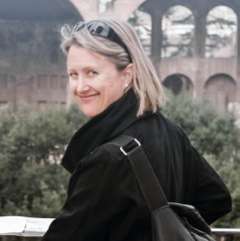It’s a safe bet to say that San Francisco Ballet patrons left the War Memorial Opera House Thursday after Program 5’s opening night, all abuzz about the same thing. "Could you believe it when that full-sized black stretch limousine glided onstage in the fog? And all that confetti! And the rest …" Indeed, the world première of Arthur Pita’s Salome gave us something to talk about.
Salome is South-African born Arthur Pita’s first major American commission, loosely based on the biblical story of Herod’s stepdaughter, who dances for him and receives John the Baptist’s head on a platter. Toss in details fromOscar Wilde's play (the Dance of the Seven Veils), inject a setting from a David Lynch film (Mulholland Drive), make it present day, and you’ve got Pita’s Salome. Set to Frank Moon’s moody, thematic score, the curtain rises on a foggy night scene as a shiny black stretch limousine glides onstage – the real deal, dazzling to behold, like a film noir come to life. From the limousine a quartet of henchmen in dark suits and sunglasses descend, visually sweep the stage and audience before giving the “all clear,” and out of the limousine come the sinister, splendid Herod and his wife, Herodias (masterfully portrayed by Val Caniparoli and Anita Paciotti respectively) and her daughter, Salome. These are powerful, unscrupulous people, and we know things are not going to end well for any of the others involved.
Salome (Dores André) is having a 16th birthday celebration. Clad in a silken, red, bare-backed gown (costume design Yann Seabra), initially she’s the picture of adolescent innocence. She’s given a cake, confetti explodes out from side cannons, filling the stage with a snowfall of papery bits. But then Herod gives her a cocktail that drugs her, as seven male hostages are brought out, and innocence evaporates. Each hostage is covered by a shroud, and in a nod to Oscar Wilde’s “seven veils” concept, Salome unveils the hostages one by one, compelling them to dance with her, until Herodias approaches and selects the victim (Aaron Robison as “John”) for her daughter.
André was brilliant as Salome in a drugged pursuit of seduction, climbing on Robison, clinging, flinging her body at him, which he caught even as he strove to elude her. Robison, a new principal to the company this season, was both a heroic and erotic figure in his disheveled, half-naked state, as he leapt, spun and lifted André. Ultimately, corralled by the henchmen, he’s dragged offstage. Minutes later, Salome is brought a platter, on which sits an object covered by a cloth. The last few minutes of the ballet are beyond riveting – unnerving, in truth –as we watch Salome respond to her prize. It’s all sexy, sinister, scandalous fare. Too edgy and experimental for the San Francisco Ballet stage, or the kind of thing the ballet world needs? Salome will likely produce strong opinions on both sides.
The program’s opening ballet, resident choreographer Yuri Possokhov’s 2008 Fusion, offered, in contrast, dreamy neoclassical beauty with an appealing blend of Eastern spirituality and Western jazz. A quartet of men (Myles Thatcher, Diego Cruz, Steven Morse and Lonnie Weeks) clad in Sandra Woodall’s flowing white chiffon skirts and red caps – think whirling dervishes – delivered movement with a perfect sense of unity. Four couples clad in unisex blue pantsuits alternated stage time with them in energetic pas de deux replete with turns, leaps, and partnered sisonne lifts with languorous arabesque extensions. Yuan Yuan Tan and Luke Ingham were particularly memorable in their pairing, with Ingham carrying her, rigid in his arms as a plank of wood. Later, a toss in the air made her body go limp, boneless like a rag doll. Tan continues to demonstrate an almost unearthly grace and flexibility to her long limbs that few dancers can match. The score's fusion of music from contemporary British composer Graham Fitkin and Bollywood film composer Rahul Dev Burman worked well, as did Benjamin Pierce’s scenic and video design – suspended white panels that subtly shifted colors and incorporated projections toward the end.
Liam Scarlett’s Fearful Symmetries, a revival from its 2016 première, finished the evening’s program. Set to John Adams’ eponymous, driving, jazz-infused composition, the ballet didn’t seem quite as dark, edgy and fearsome this year (literally on the former; lighting has been increased), no surprise, given its placement after Salome. David Finn’s white, horizontal bars of light against a dark backdrop, along with Jon Morrell’s dark grey costumes, nonetheless lent an urban, post-apocalyptic touch. The ballet’s title references text from the 1794 William Blake poem, The Tyger, and one can see that feline, feral, on-the-prowl restlessness in the choreography and Adams’ score. The dancers met the ballet’s fierce, driving pacing head-on. Frances Chung’s always impressive energy and attack were at their finest, partnered by Vitor Luiz, and Joseph Walsh delivered an irresistible solo, full of verve and personality. Intriguing passages abounded for all the dancers; Jennifer Stahl charmed, and memorable was the image of Lorena Feijoo riding atop Luke Ingham on all fours, movements deliberate and sensuous. Music director Martin West and the San Francisco Ballet Orchestra helped keep the pace propulsive, capping off an evening of dance that stretched out from the sinister to the sublime.


